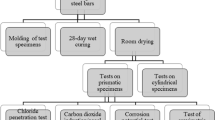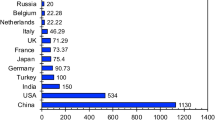Abstract
Results of a statistical analysis of transport properties measurements carried out on a number of concrete mixtures are presented. Migration and drying experiments were performed to evaluate the ionic diffusion coefficients and permeability of concrete mixtures. Seven concrete mixtures were tested. The mixtures were either batched under laboratory conditions or sampled from construction sites. For each mixture, approximately eighty concrete samples from a single batch were tested. Ionic diffusion coefficients were calculated by analyzing the evolution of the electrical current passing through concrete samples during the migration tests. Calculations took into account the volume of permeable pores of the materials and the pore solution chemistry. Permeability was calculated from mass loss measured during drying tests. The study indicates that the coefficient of variation of ionic diffusion coefficients is 11.1 % on average, with a maximum of 23.5 %, and that the coefficient of variation of permeability is 20.6 % on average, with a maximum of 37.3 %.





Similar content being viewed by others
Notes
The incorporation of performance language began in the 1994 edition but was significantly reviewed in 2004.
D OH was selected because hydroxide is always present in cementitious materials, whereas the presence of chloride depends on the external environment
Reference
AIP (1972) American Institute of physics handbook, 3rd edn. McGraw-Hill, New-York
ASTM (2006) ASTM standard C642. Standard test method for density, absorption and voids in hardened concrete. ASTM International, West Conshohocken
ASTM (2010) ASTM standard C1202. Standard test method for electrical indication of concrete’s ability to resist chloride ion penetration. ASTM International, West Conshohocken
Berner UR (1992) Evolution of pore water chemistry during degradation of cement in a radioactive waste repository environment. Waste Manage 12:201–219
Bolton D. (1980) The computation of equivalent potential temperature. Mon Weather Rev 108:1046–1053
Brouwers H.J.H., van Eijk R.J. (2003) Alkali concentrations of pore solution in hydrating opc. Cem Concr Res 33:191–196
Conciatori D, Brühwiler E, Morgenthaler S (2009) Calculation of reinforced concrete corrosion initiation probabilities using the rosenblueth method. Int J Reliab Saf 3(4):345–362
Conciatori D, Laferrière F, Brühwler E (2010) Comprehensive modelling of chloride and water ingress into concrete considering thermal and carbonation state for real climate. Cem Concr Res 40:109–118
CSA (2004) Concrete materials and methods of concrete construction / Methods of test and standard practices for concrete A23.1-04/A23.2-04. Canadian Standards Association, Canada
Galbraith G.H., McLean R.C., Kelly D. (1997) Moisture permeability measurements under varying barometric pressure. Build Res Inf 25:348–353
Glasser FP, Marchand J, Samson E (2008) Durability of concrete—degradation phenomena involving detrimental chemical reactions. Cem Concr Res 38:226–246
Helfferich F (1962) Ion exchange. McGraw-Hill, USA
Henocq P, Samson E, Marchand J (2012) Portlandite content and ionic transport properties of hydrated C 3S pastes. Cem Concr Res 42: 321–326
Huang YH, Adams TM, Pincheira JA (2004) Analysis of life-cycle maintenance strategies for concrete bridge decks. J Bridge Eng 9:250–258
Kirkpatrick TJ, Weyers RE, Sprinkel MM, Anderson-Cook CM (2002) Impact of specification changes on chloride-induced corrosion service life of bridge decks. Cem Concr Res 32:1189–1197
Liu Y, Weyers RE (1998) Modeling the time-to-corrosion cracking in chloride contaminated reinforced concrete structures. ACI Mater J 95:675–681
Marchand J, Ouellet E, Samson E (2012) Improving the service life of concrete construction through performance-based specifications. In: International congress on durability of concrete, Trondheim, Norway
Millington RJ, Quirk JP (1961) Permeability of porous solids. Trans Faraday Soc 57:1200–1207
Robinson RA, Stokes RH (2002) Electrolyte solutions, 2nd edn. Dover Publications, New-York
Rosenblueth E. (1975) Point estimates for probability moments. Proc Natl Acad Sc. USA 72:3812–3814
Rosenblueth E (1981) Two-point estimates in probabilities. Appl Math Model 5:329–335
Samson E, Henocq P, Marchand J, Beauséjour P (2008) Recent advances in the determination of ionic diffusion coefficients using migration test results. In: Schlangen E, de Schutter G (eds) RILEM proccedings 58-CONMOD 2008, Delft, The Netherlands
Samson E, Maleki K, Marchand J, Zhang T (2008) Determination of the water diffusivity of concrete using drying/absorption test results. J ASTM Int 5
Samson E, Marchand J (2006) Multiionic approaches to model chloride binding in cementitious materials. In: 2nd international symposium on advances in concrete through science and engineering, Quebec City, Canada
Samson E, Marchand J (2007) Modeling the transport of ions in unsaturated cement-based materials. Comput Struct 85:1740–1756
Sercombe J, Vidal R, Gallé C, Adenot F (2007) Experimental study of gas diffusion in cement paste. Cem Concr Res 37:579–588
Xi Y, Bazant ZP, Molina L, Jennings HM (1994) Moisture diffusion in cementitious materials moisture capacity and diffusivity. Adv Cem Based Mater 1:258–266
Xu T, Samper J, Ayora C, Manzano M, Custodio E (1999) Modeling of non-isothermal multi-component reactive transport in field scale porous media flow systems. J Hydrol NZ 214:144–164
Zhang G, Zheng Z, Wan J (2005) Modeling reactive geochemical transport of concentrated aqueous solutions. Water Resour Res 41:W02018
Author information
Authors and Affiliations
Corresponding author
Rights and permissions
About this article
Cite this article
Conciatori, D., Grégoire, É., Samson, É. et al. Statistical analysis of concrete transport properties. Mater Struct 47, 89–103 (2014). https://doi.org/10.1617/s11527-013-0047-z
Received:
Accepted:
Published:
Issue Date:
DOI: https://doi.org/10.1617/s11527-013-0047-z




